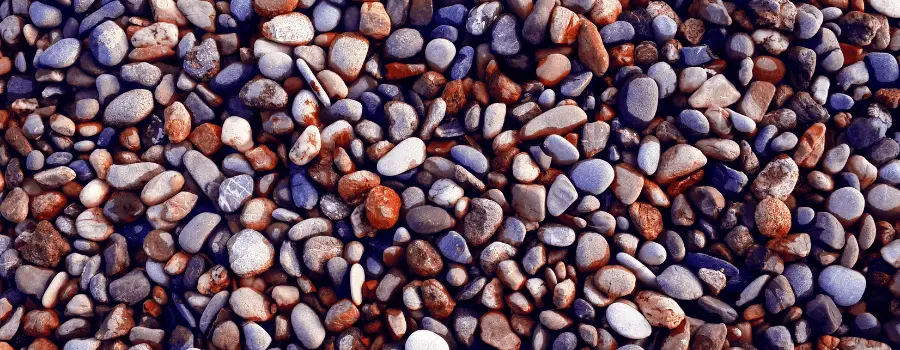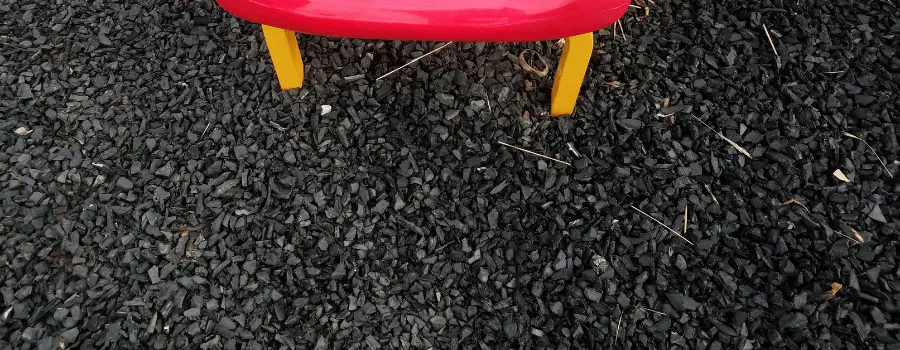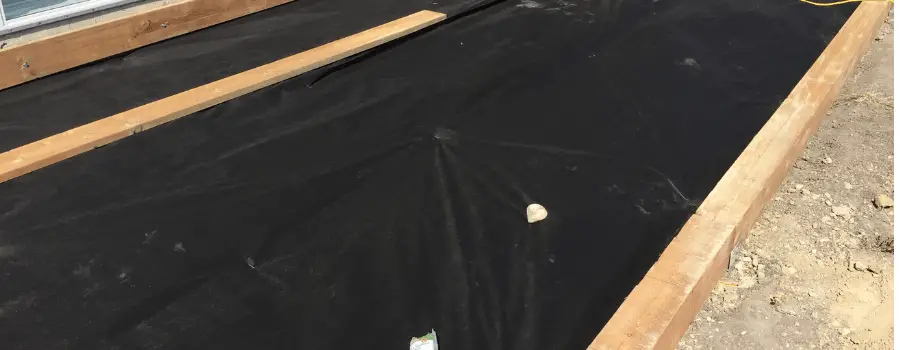Using the right material under a deck is an important part of building a deck. Raising the question, what is the best material to put under a deck?
The best material to put under a deck is landscape fabric covered by non-organic materials like gravel or crushed stone. The landscape fabric stops weeds from growing under your deck, and the gravel holds down the fabric while allowing for drainage.
Material under a deck is both about aesthetics and function. You do not want to place anything that will damage your deck by trapping moisture or increasing fungi growth. At the same time, a deck should look clean and tidy underneath.
Is there anything that makes a deck look more neglected than a weed poking its head through the decking? If not addressed during construction forevermore, you will be fighting a losing battle against weeds. Pulling only the top of the weeds off will leave them returning in a few days. Herbicides may kill them, but with the possibility of damaging your decking with harsh chemicals. Besides, you can only spray them one at a time. Tomorrow more will come.
The ground under a deck should be covered with landscape fabric and gravel.
Let’s start with the visible material under your deck, but don’t ignore the need for weed control. Controlling weeds under a deck is best done with landscape fabric. Please read to the end when we discuss what landscape fabric to use under your deck. But starting with the visual, the material holds down and protects the landscape fabric.
Why Place Non-Organic Material (Gravel) Under a Deck?
Material holding the fabric down under your deck must be non-organic.
Because it does not absorb water while allowing water to drain.
Organic materials such as bark mulch or wood chips will absorb water and decompose. Organic material also harbours fungi which can rot wood.
Plus, organic material will break down, requiring regular replacement. Where once placing gravel under your deck, you will only need to occasionally rake it, but no additional material will be needed.
Weed Control
Gravel is not a good material for weed seeds to sprout. Minimizing the number of weeds growing under the deck.
Prevent Erosion
The heavy gravel not only holds the landscape fabric down but minimizes rain washing away the dirt under your deck.
Along with working like a screen slowing down the speed in which the water hits the ground.
Drainage
Probably the most important reason for gravel is drainage. Washed gravel or screened rocks will allow the water to drain, preventing water pooling and mosquitos from hatching under your deck.
Aesthetics
It’s part of your yard, and you want it to look good.
Gravel raked out level under a deck is appealing to the eye. Making it a beautiful part of your yard, not an ugly erosion spot of bare dirt.
Usability
Gravel is great in that you can still use the space under the deck covered by gravel.
The gravel will stay largely clean for walking on. Making climbing under your deck to reach yard tools or chairs not a disgusting, dirty activity.
There are so many great possibilities for gravel under a deck.
What is the Best Size of Gravel for Under a Deck?
Larger Than ¼” But Ideally 3/4″
Landscape fabric blocks light, but it will not stop roots. Taproot weeds like dandelions can easily push through the fabric. Sneaking their roots through the permeable fabric and ripping a hole for their roots. Material holding down the fabric must be large enough not to trap moisture which can germinate weed seeds, and sprouting roots.
Sand can trap enough water to allow the seeds to germinate. This is why you need screened material larger than 1/4″.
How Deep Should Gravel Be Under a Deck?
Gravel should be spread out to a depth of 2” (50mm) or more inches over the landscape fabric under your deck.
This is deep enough to cover the fabric and prevent weed growth. It is also a nice working depth for raking the gravel.
The quick math for how much gravel you will need to order for under your deck is.
1 yard of gravel covers 100 square feet 2” (50mm) deep.
Rake it out level with the rake upside down so it won’t catch and tear the landscape fabric.
Best Types of Gravel for Under Decks
There are a number of gravel options and reasons to choose them for under your deck, from aesthetics to economics.
For decks less than 24” (0.6m), the main concern is weed control. Selecting an economical material to hold the landscape fabric down will protect the ground under your deck while saving you cash.
Some good options are.
Screened Crushed Rock
Rock which has been crushed or broken down into useful sizes. It’s important that it is screened to avoid sand and other small particles acting as weed nurseries. Not amazing in colours but comes in off-white, grey, reddish-brown and tan. Nothing really to look at but one of the most economical covers for landscape fabric.
A deck with skirting is an ideal match, nothing fancy, but at a good price.

Natural Washed Rock
Similar to crushed rock, except it often riverbed 14-25 mm (3/4-1”) gravel, washed to remove small particles and dirt.
Gathered from riverbeds were they were naturally washed.
Often they are more rounded from the tumbling in the running water. Giving them a softer look as opposed to a crushed rock angular appearance. About one and half times more in price than crushed rock, depending on regional availability, but often with greater variety in gravel colour.
Drain Rock
Think bigger washed rock, 40 mm (1 5/8”) or larger rock cleaned to prevent weed growth and allow drainage.
Its size is both an advantage and disadvantage; the large size ensures that weeds will not grow with no compacted fine particles for germination.
The disadvantage is that it’s harder to place. Your rake often bounces as it hits the larger, heavy stones.
But it does provide excellent drainage for under your deck. Costing slightly more than crushed rock.
Not my first pick in ground-covering under a deck, but if drainage is critical. Drain rock lives up to its name, providing excellent drainage.
Under Raised Decks, Ground Cover to be Seen
Decks higher than 24” (0.6m) without skirting may look better with more visually appealing ground cover. Adding both colour and style under a deck.
Pea Gravel
The name says it all, small rocks about the size of a pea, between 1/8”-3/8”. A very small but beautiful decorative stone. Coming in a range of different natural colours like buff, rust-brown, shades of gray, white, and translucent. Rock to be seen, a higher deck with no skirting, this is an excellent choice.
I love the feel of these small rocks running through my fingers, probably why you will often find pea rocks around playground equipment. A beautiful, small rock that keeps down weeds looks good and feels great on your hands.
Rundle Rock
A possible option for an open deck without skirting high enough to view. Rundle rock is similar to crushed rock. Angular in shape but a charcoal colour. When sprayed down, the depth of its colour is renewed. A nice dark colour for under a deck.
A pricier option for material under a deck. Costing around two and half times as much as crushed rock. But a good option when the underside of your deck is part of the aesthetics of your yard.
Ideal for a higher deck, in a prominent part of the yard,
Rainbow Rock
Similar to naturally washed rock except with a rainbow of colour. With a wide range of eye-popping colours in a convenient levelling size.
Get ready to pay for this beauty, as rainbow rock is often over twice as much as crushed rock. If your deck is high enough and you would like to add some more colour under your deck, rainbow rock is a good option.

Tan Rock
A good decorative stone but an earth tone colour, as the name says “Tan.” With pressure-treated decks often stained brown, this is a nice complimentary lighter brown colour to go under it. Not attention-grabbing but a calmer colour without going grey. Cheaper than most decorator stones but more than crushed rock.
Non-Stone Material for Under a Deck
Stone is always my first option for under-deck material. It is natural, durable and suppresses weed growth, but if you are looking for something different. Here are some possible non-organic options for under a deck.
Shredded Rubber Mulch
Shredded tires are similar in appearance to wood mulch but not organic and will not decompose. Often a darker colour as its natural tire state but can be dyed for a more natural colour. Lighter in weight than stone but sticking together, minimizing movement.

Some of rubber mulch’s drawbacks are the fact it’s not natural. On hot summer days, it can off-gas a rubber smell. Hey, if you like to go down to the drag track on summer days, this might be ideal for you. It will also leak chemicals into the soil, destroying soil health. Not a big deal because you don’t grow vegetation under the deck, but something to make a note of.
It not being a “natural” product is very effective in weed suppression. Weeds want nothing to do with it, which is advantage. Promising to last over 50 years, it will outlast most decks except for maybe your Ipe decking.
Crushed Recycled Glass
Crushed tumble glass, with soft non-cutting edges, glimmering amazing vibrant colours. If you want the material under your deck to be the star, glass may do it. There are few materials with as much life and colour to put under your deck. Sparkling with vibrant blues, purples and greens, plus many more colours, crushed glass is the most decorative of under-deck options.
With pricing starting at around $40 a square foot, this is going to be costly. More costly than your composite or even Ipe decking. Possibly better to be used to add colour to spots under a deck without covering the entire area.
Possible Organic Material for Under a Deck
You do not want bark mulch, wood chips or any other material decomposing and trapping moisture under your deck. But if you have a deck high enough to work under but too low to enjoy as a shaded patio . A deck between 3’-5’ (1-1.5m) high, an option is low growing ground cover plants.
. A deck between 3’-5’ (1-1.5m) high, an option is low growing ground cover plants.
Plants under a deck must be shade plants, thriving with little sunlight. Also, they must not grow too tall, reaching your deck or poking through the decking. So, ground-hugging, low light thriving vegetation.
“Pachysandra is perfect for planting underneath decks”
John Walke
Some other options for low-growing, shade-loving vegetation are hostas, coleus, impatiens or begonias. Once established, it will green up the ground under the deck but will require time to take hold and cover the ground under your deck. You will spend much time initially, crouched over planting and then caring for them but bringing life under your deck.
If you do not go with intentional vegetation under your deck, you will need to control the weeds. Even gravel 2” (50mm) deep will not sufficiently stop weeds.
Landscape Fabric Under Gravel
The fabric is to stop the weeds, and the gravel is to hold the fabric in place while allowing drainage. Our greatest concern being weeds. Let’s consider what landscape fabric does and what we should look for when buying.
Landscape fabric does not kill weeds. Let me repeat myself. Landscape fabric does not kill weeds. Landscape fabric is designed to block light. Without sunlight, weeds cannot grow. If you block the light, you stop the weeds.

Since landscape fabric does not kill weeds, it is best to remove all weeds before building your deck. Pulling out the bigger weeds and spraying the smaller ones to ensure that they do not push through the landscape fabric reaching for the light. Landscape fabric can stop seeds from sprouting, but established weeds must be removed before installation.
There are many levels of quality of landscape fabric.
You will want to install a quality fabric lasting many years. Wood decking lasting between 15 -20 years depending on care, composite decking last 25-plus years. The landscape fabric needs to last as long as the deck, as you will not want to be replacing it during the life of the deck. Low decks are hard to work under.
Quality landscape fabric is heavy compared to lower-quality fabric. A 150 square foot roll weighing 20 lbs or more will be a thicker fabric lasting longer. Sometimes the fabric will be labelled based on weight. 5 ounces or better is good.
Some landscape fabric is also UV resistant but is not required under your deck as both the deck and the gravel will be shielding the fabric. Think flat roofs and gravel. It’s the tar that stops the rain, but the gravel protects the tar from UV.
Some fabric will come with a warranty based on years, either 5, 10 or even 25 years. The challenge is under what condition will it last that long. If all other things are equal, if it promises additional years, then use that one as any additional years stopping weeds under your deck is a good thing, especially if it’s only a few extra bucks.
Speaking of cost, landscape fabric will cost between 5 to 15 cents a square foot, depending on the quality and size of the roll. Per square foot, you will save more money buying a larger roll.


A 20’x12’, 240 square foot deck will need roughly 300 square feet of fabric and 144 pins when accounting for overlap.
Stopping Light Not Water
The challenge with landscape fabric under your deck is water. All material under your deck needs to allow water to drain. Pooling water under your deck will raise moisture levels increasing wood rot and mould. The landscape fabric must be permeable to water. It is better if the fabric designs are permeable to water than perforated after.
Also, helpful limiting water under your deck-levelling out the ground and removing areas in which water can pool. Then when there is a downpour, the water will run out from under your deck into your yard. The grass will love it, and the deck will last longer.
Speaking of water, always make sure that the downspouts of your house are directed away from under the deck. The increased water will become trapped under your deck with the decking shading it, slowing evaporation. The increasing moisture level under the deck will increase rotting, destroying your joist and decking.
Roll out the landscape fabric with the rough side down, helping the fabric to stay in place as you work. Pin it down with landscape pins every foot or so. Keeping it in place till you have the gravel on it. To ensure that no weeds sprout between layers, overlap 6-8 inches.
Landscape fabric alternative
Plastic is not permeable and should not be used under your deck. Plastic will trap water under your deck, causing damage. Also, small pools of trapped water becoming breeding grounds for mosquitoes. These pesky insects will annoy you to no end while you’re trying to relax on your deck in the cool of the evening.

Using Cardboard or newspaper instead of fabric to suppress weeds? I love this idea for my garden. Just recently, I did it around my raspberry bushes to save on weeding and increase moisture in the ground. It worked wonderfully, weed-free garden all summer, with thriving bushes.
“it takes approximately 2 months for cardboard to decompose.”
Reference
But I will need to replace it again in the spring. Cardboard will not last long enough to stop weeds for the life of your deck.
Final Touch
It’s a good idea to edge the gravel with a landscaping edger. This doesn’t need to be expensive or complicated, but something to clearly define where the deck ends and the grass begins. Otherwise, your deck gravel will start spreading out into the lawn and the grass will start growing under the deck. Making your yard look messy. Besides, you don’t want to be hitting gravel with your mower.
A roll of plastic lawn edger is the most economical and easiest to install. You can also fence off the gravel with a treated 2×4 on the edge or pavers, giving it a more rigid and solid look. Whatever you choose, a clearly define yard will keep your yard and deck looking good.
